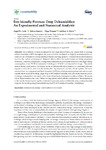Eco-friendly Pressure Drop Dehumidifier: An Experimental and Numerical Analysis
Title
Eco-friendly Pressure Drop Dehumidifier: An Experimental and Numerical AnalysisDate
2019Citation
Costa, Á.M.; Bouzón, R.; Vergara, D.; Orosa, J.A. Eco-friendly Pressure Drop Dehumidifier: An Experimental and Numerical Analysis. Sustainability 2019, 11, 2170. https://doi.org/10.3390/su11072170
Abstract
[Abstract] The northwest of Spain is defined by very high relative humidity values, with an average relative humidity of 85% throughout the year, which is considered too high by most standards and therefore can be related to various health problems and fungi growth. To reduce the relative humidity level in the indoor environment, different dehumidification technologies are being employed.
However, commonly employed cooling based dehumidification systems have a very high energy consumption, from 720 W in residential buildings to 3150 W in industrial buildings. This article aims to show a new method for indoor moist air dehumidification, based on a controlled adiabatic expansion of moist air, similar to the Foehn effect, by means of a nozzle–diffuser system. The main results, based on computational fluid dynamics (CFD) simulations and experimental tests in wind tunnels, show an initial working range of up to 80% relative humidity, with almost ten times reduction in energy consumption compared to the classical mechanical refrigeration dehumidifiers. Moreover, future improvements, such as a Peltier cooling system, which allows a reduction of the temperature in the nozzle throat, improving the condensation process, and a variable inlet area, could potentially improve the working range towards the required 30–60% relative humidity in buildings.
Keywords
Dehumidifier
Energy consumption
CFD
Nozzle
Energy consumption
CFD
Nozzle
Editor version
Rights
Atribución 4.0 (CC BY)
ISSN
2071-1050







